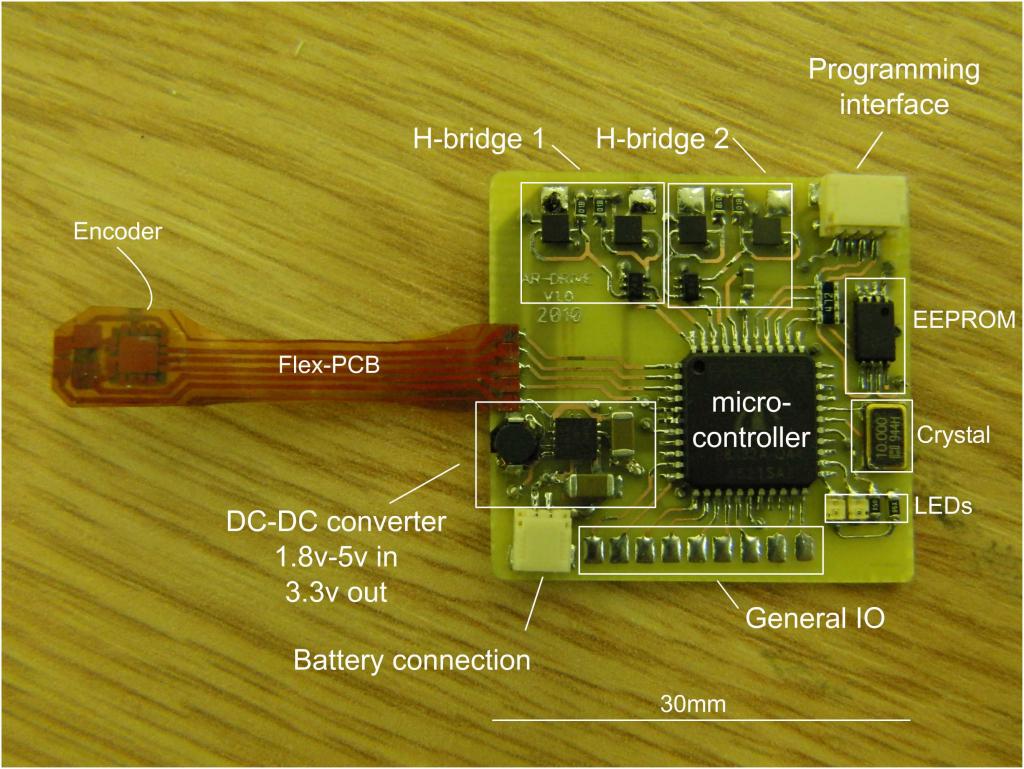A little propeller board
 Graham Stabler
Posts: 2,510
Graham Stabler
Posts: 2,510
I've been meaning to post a pic of this for a while, something I developed as part of my research. Propeller, eeprom, two h-bridges and buck-boost converter (to run from lipoly 3-4.2v in 3.3v out) and the somewhat more application specific magnetic encoder on homemade flex PCB.
Double sided PCB with wire for vias but components on the top only. Soldering the dual mosfets was a real pain but got there in the end. I think they are rated for something like 7A with suitable PCB but I will run sub 1amp.
Graham

Double sided PCB with wire for vias but components on the top only. Soldering the dual mosfets was a real pain but got there in the end. I think they are rated for something like 7A with suitable PCB but I will run sub 1amp.
Graham



Comments
Nice board.
What type of driver IC's -- that ones 6 pin's You use to drive H-Bridges!
This thing is supposed to go in flying machines if I work out the kinks.
Graham
Thanks
I don't need big frequencies to.
I definitely stole the idea of the array of pull up resistors for programming from Phil!
Graham
I know you've been studying flying-insect kinematics for a long time. Is this the inevitable next stage? IOW, do the dual H-bridges drive the wings of a radio-controlled moth?
-Phil
Would this be suitable for something like Festo robo bird that erco posted?
http://forums.parallax.com/showthread.php?133653-Robo-Bird
I've been wanting one of these since I was ten years old, but never got the wing motion right. Seems so simple now that someone else has done it.
Lawson
Prof, nothing like that. BTW, what Festo did is very similar to Holst and Hertzog, check the link at the top of this page: http://www.indoor.flyer.co.uk/buzzard.htm This page shows my attempt at a model with actively twisting wings a la Holst. Notice that I also tested mine on a ring that goes around and around like Festo did
Lawson, not sure I understand the grounding issue but seems to work. The high side mosfet needs the battery voltage to turn it off hence I can't drive from the propeller pin at 3.3v.
Graham
The grounding issue is something I've seen in other higher power H-bridge designs. Basically, the power ground trace acts as a tiny inductor so when the input current changes due to the fets switching, a voltage is induced along the trace. In higher power/speed situations this voltage can get high enough to fry the gate or driver if logic ground isn't pulled from under the Fet gates. (in your case, power and power-ground are tightly paired which helps a lot by lowering inductance)
For the Fets I'd have to look at the Idd-Vgs curves to be sure, but the p-fet may be off enough with -0.9v on it's gate (fresh charged Li-po) to work fine. Similarly, with a dead Li-po and 0.1 Vgs the p-fet will just be more "off" than usual. I've also had good success with a capacitive level shifter to drive fets. A capacitor goes between the prop pin and the Fet, then two resistors and a diode are used to define the start up state and voltage range of the level-shifter's output. (ironically this likely takes more space than your solution...)
Lawson